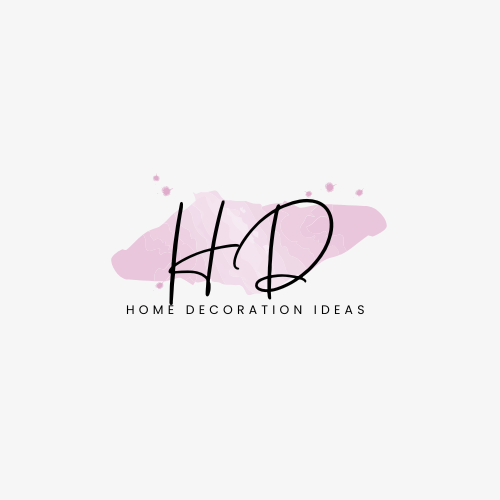Entryway Styling Ideas for Small Homes: 12 Practical Tips to Maximize Space and Style
Small homes often come with limited space, making it important to use every inch wisely. Entryways are key areas that set the tone for the rest of the house and need to be both functional and welcoming. Effective entryway styling can help maximize space while keeping the area organized and attractive.
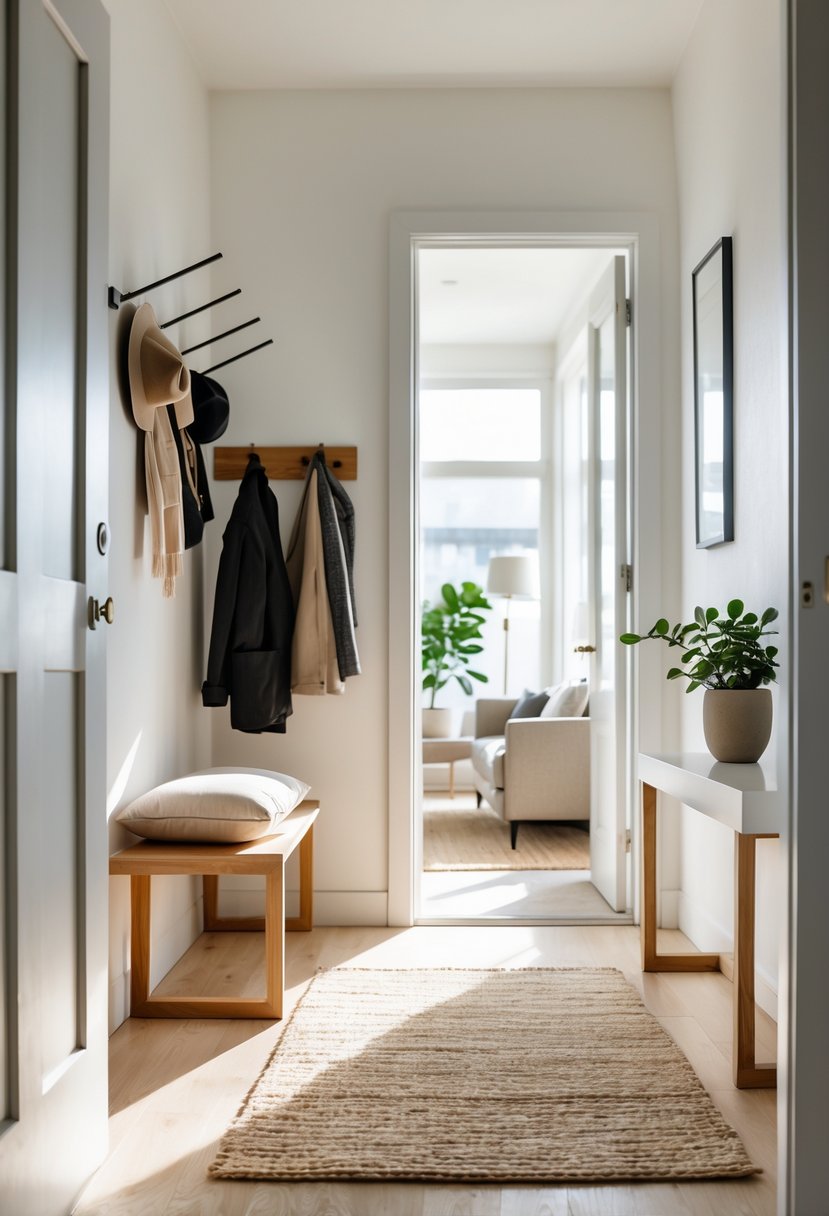
Many people look for ways to improve their small entryways without clutter or crowding. Styling these spaces thoughtfully allows for a balance between storage, decoration, and ease of use. This article explores ideas that work well in small homes to create entryways that are both practical and stylish.
1) Use a slim console table with built-in storage
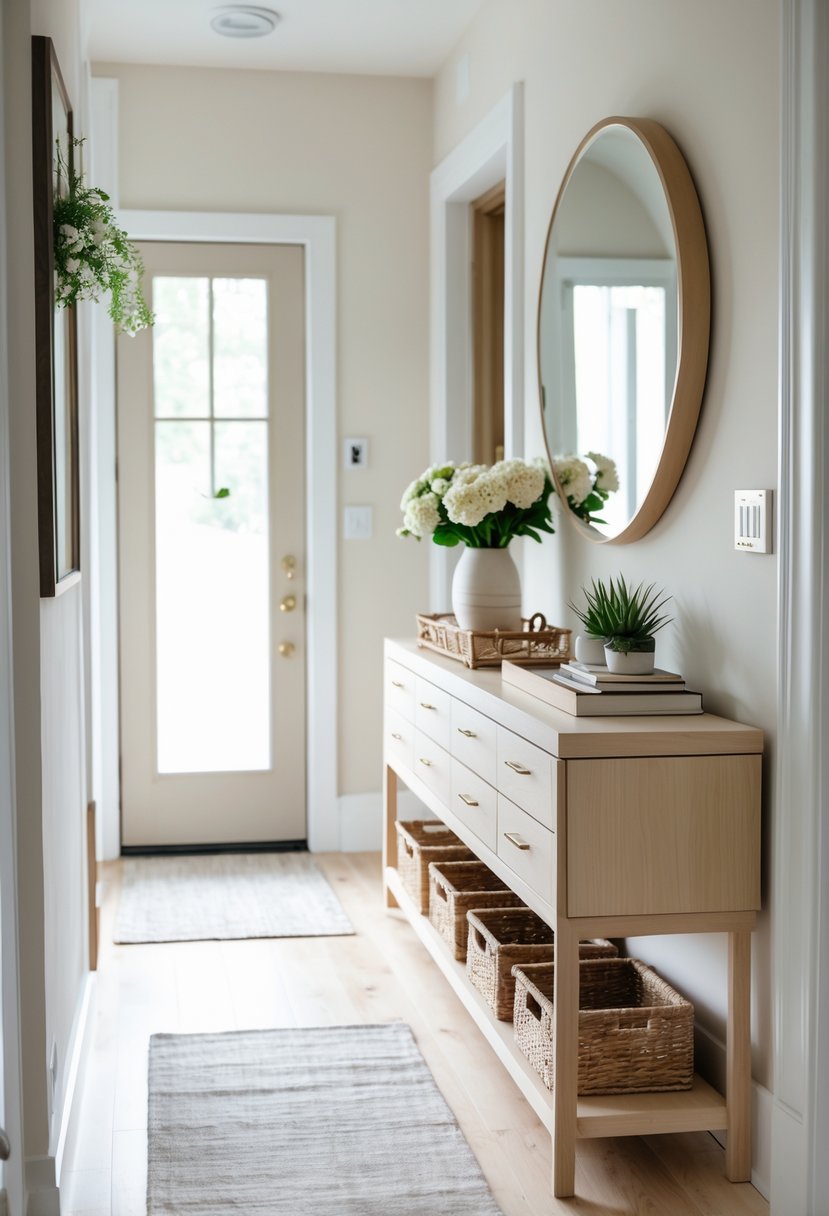
A slim console table fits well in narrow entryways without taking up much space. Built-in storage like drawers or shelves keeps essential items organized and out of sight.
It helps reduce clutter by holding keys, mail, and other small items. This makes the entryway both functional and tidy.
Choosing a table with a simple design ensures it blends with the rest of the home’s decor. This creates an inviting and practical entryway in small homes.
2) Install wall-mounted hooks for coats and bags
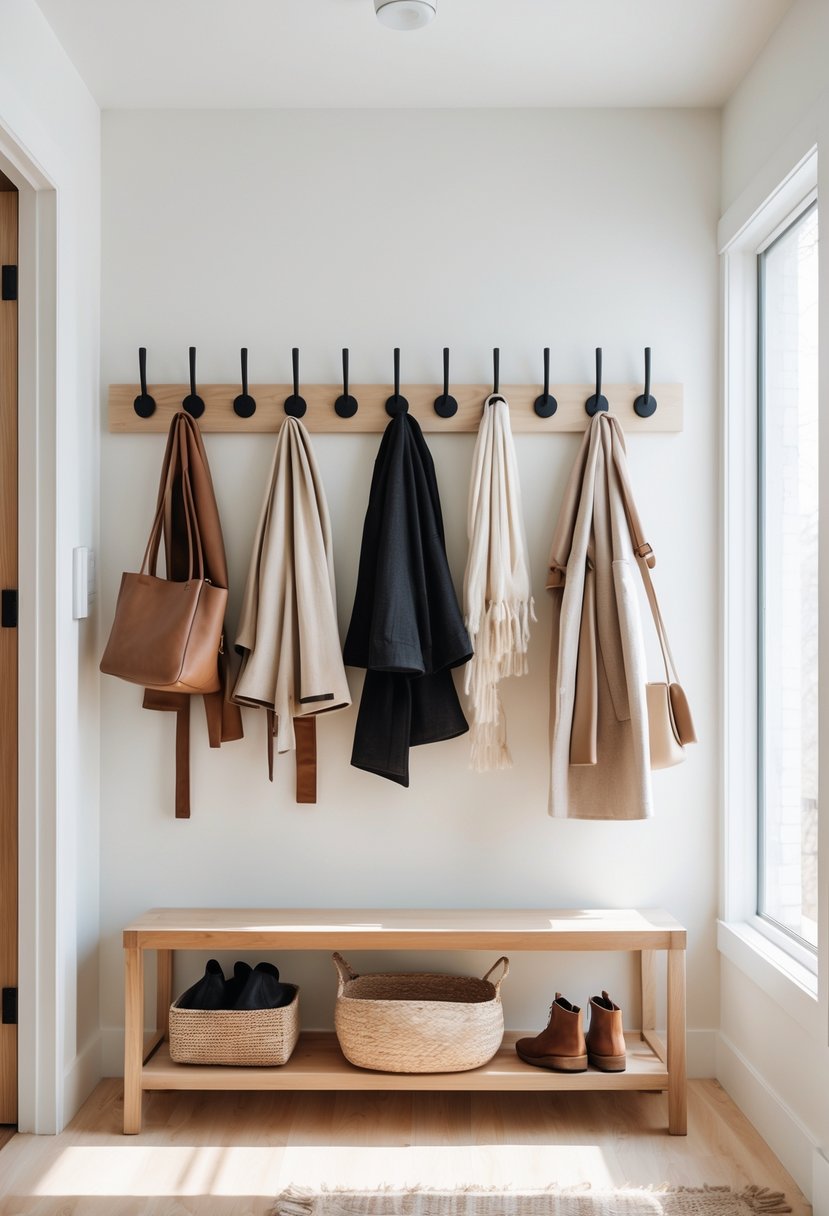
Wall-mounted hooks save space by keeping coats and bags off the floor. They work well in small entryways because they use vertical space efficiently.
Hooks come in many styles, from simple metal designs to decorative wooden options. This allows homeowners to match their decor while staying organized.
To install, find wall studs for secure mounting. Evenly spacing hooks ensures enough room for each item and keeps the area tidy.
3) Add a decorative mirror to visually expand the space
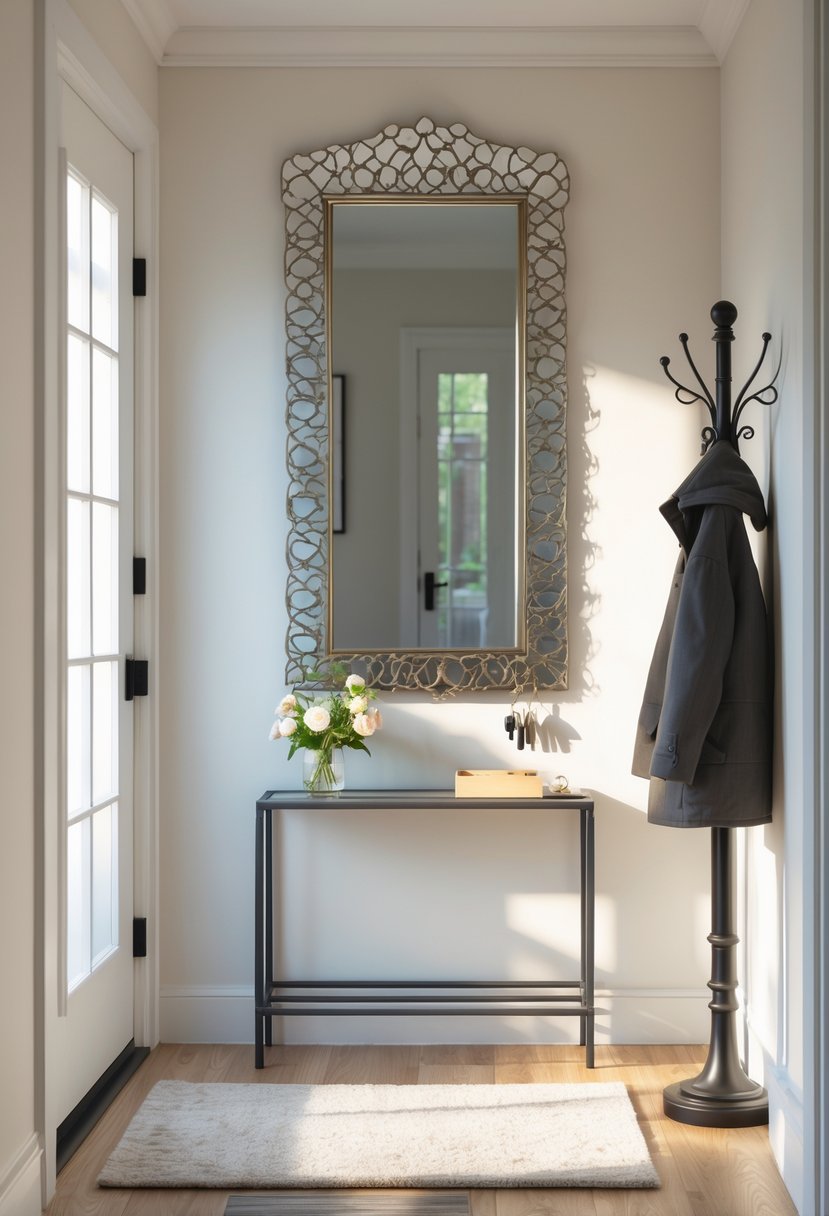
A decorative mirror can make a small entryway feel larger and brighter. It reflects light and opens up the area without taking up extra room.
Choosing the right size and shape is important. Large or uniquely shaped mirrors draw attention and add style.
Mirrors with simple, clean frames suit modern spaces, while rustic or ornate frames add warmth and character. The right mirror balances function and design.
4) Place a cushioned bench with hidden storage underneath
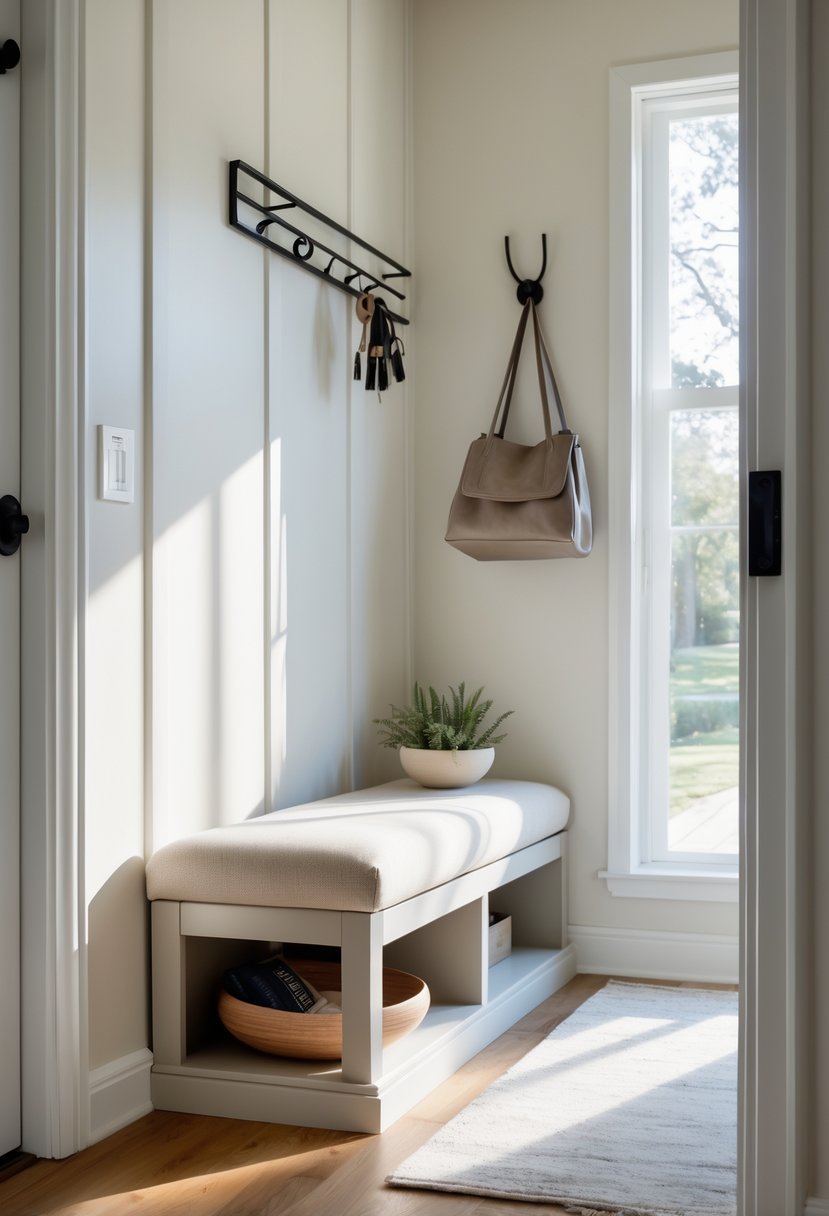
A cushioned bench offers a comfortable place to sit while adding function to a small entryway. The hidden storage underneath helps keep shoes, bags, or other items out of sight.
This type of bench maximizes space and reduces clutter. It also makes the entryway look neat and organized without taking up much room.
5) Incorporate floating shelves for keys and mail
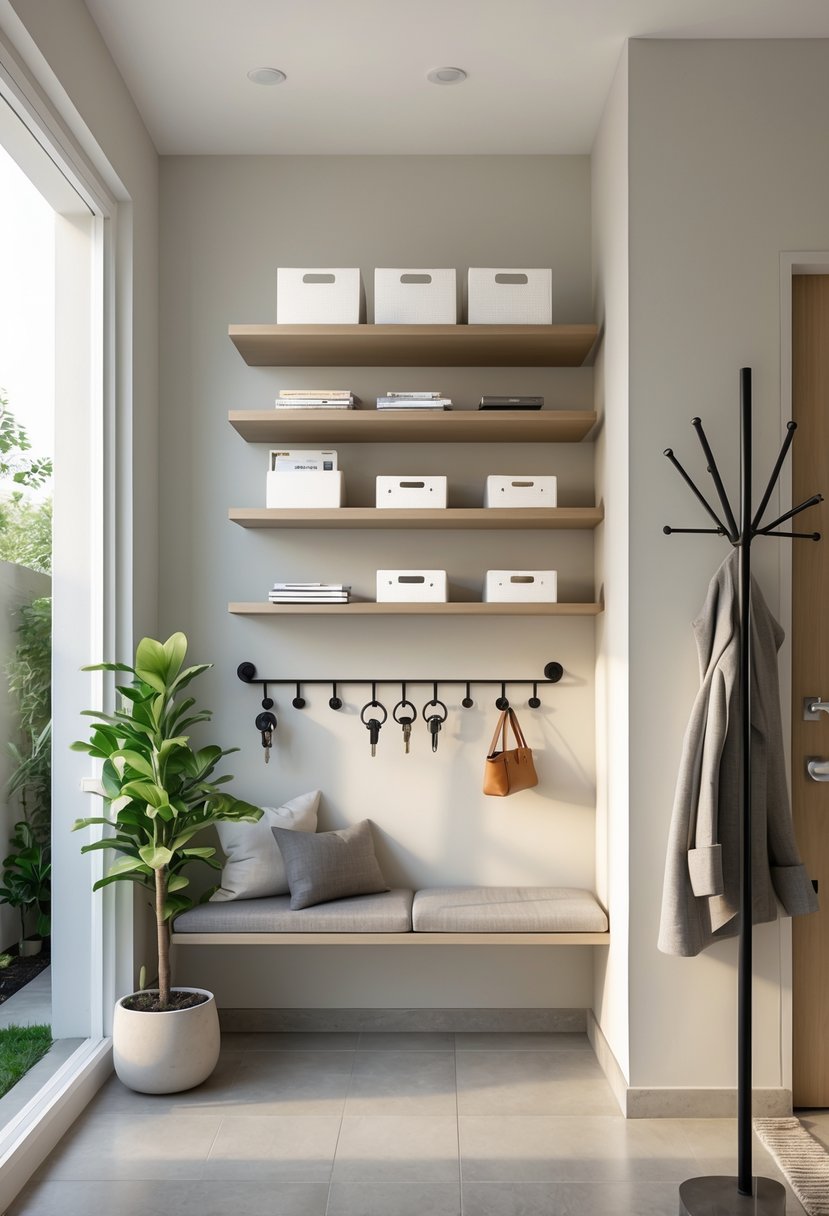
Floating shelves save space by mounting on walls, keeping floors clear. They provide a handy spot to store keys, mail, and small items near the door.
These shelves help keep the entryway organized and clutter-free. Choosing neutral colors can make the area look simple and clean.
Adding small decor like plants or lanterns can make the shelves look nice without crowding the space. This makes the entryway functional and welcoming.
6) Choose narrow shoe racks to keep footwear organized
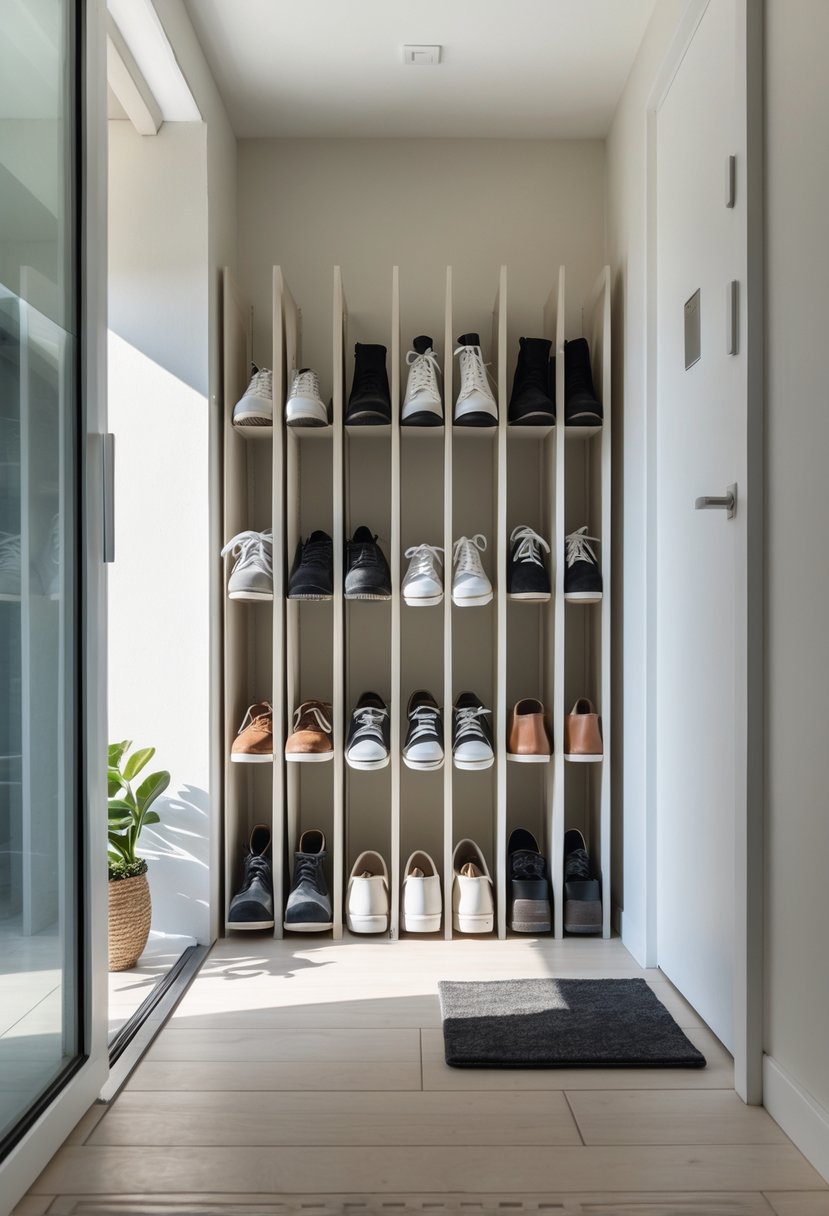
Narrow shoe racks fit well in small entryways. They use less floor space while holding several pairs of shoes.
These racks help keep shoes off the floor, reducing clutter. Many designs slide under benches or fit into tight corners.
Using slim racks makes it easier to find and store shoes quickly. This keeps the entryway neat and functional without crowding the area.
7) Apply light, neutral paint colors to brighten the area
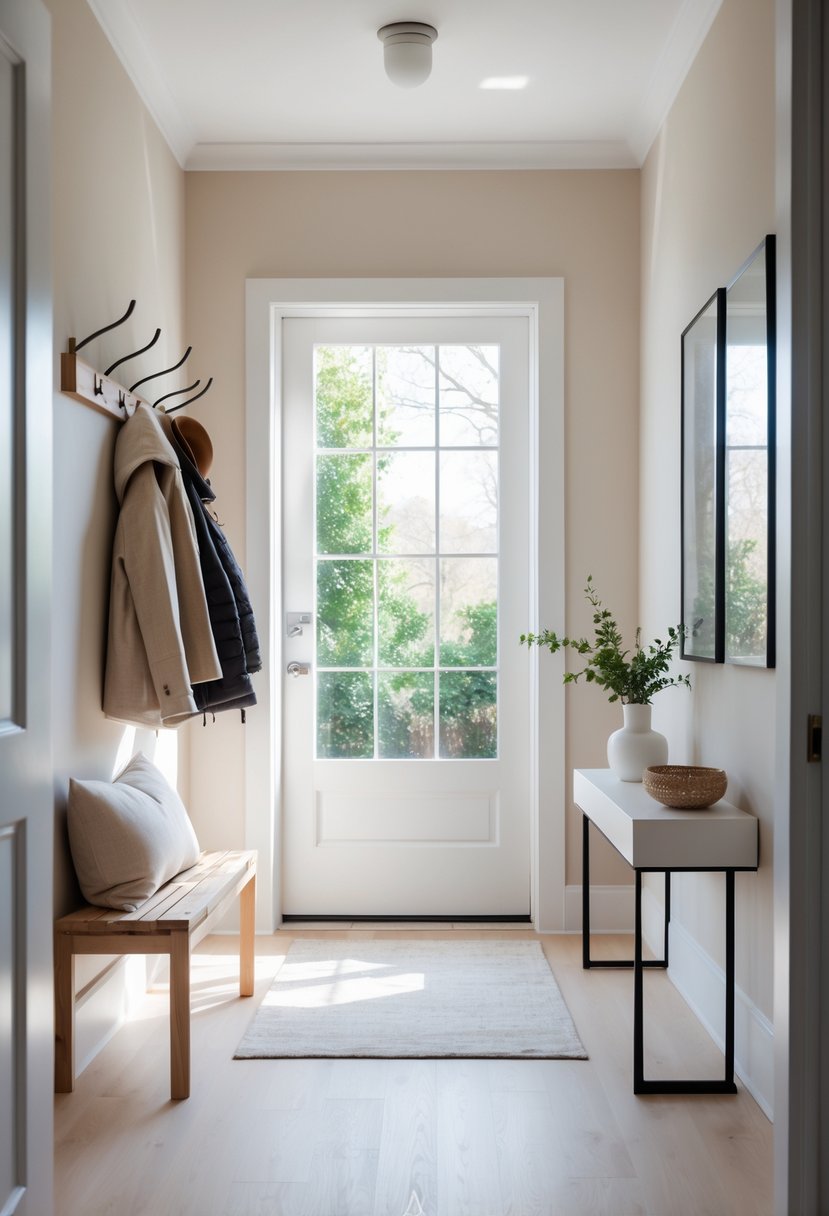
Light, neutral paint colors help open up a small entryway by reflecting more natural and artificial light. Shades like soft beige, creamy white, or pale gray work well to make the space feel larger and cleaner.
Choosing a paint color slightly lighter on the ceiling adds height, drawing the eye upward. This simple trick can prevent the area from feeling cramped or dark.
8) Use baskets or bins for miscellaneous items
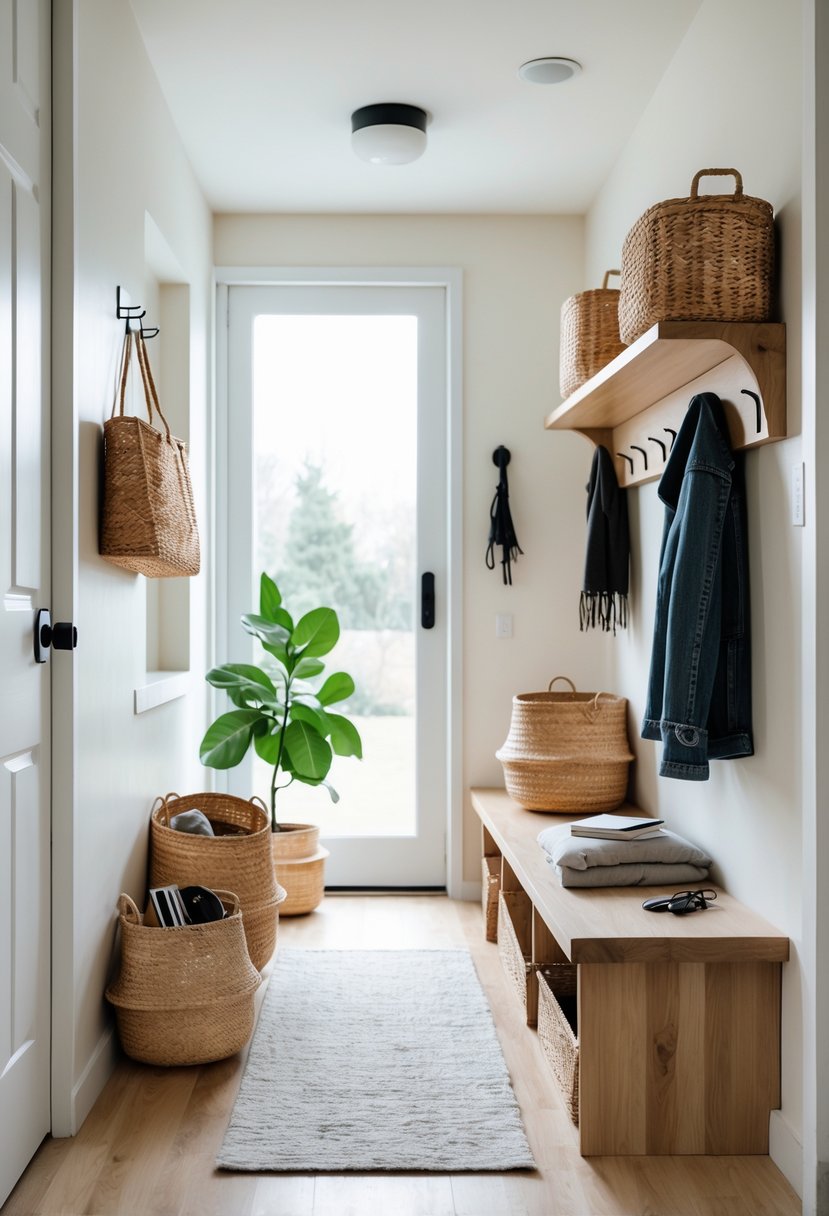
Baskets and bins help keep small entryway items organized. They can hold things like keys, mail, and shoes that might otherwise clutter the space.
Using baskets under a table or on shelves makes it easy to grab what is needed quickly. Choosing containers that match the home’s style adds both function and a neat look.
9) Hang a pegboard for flexible storage options
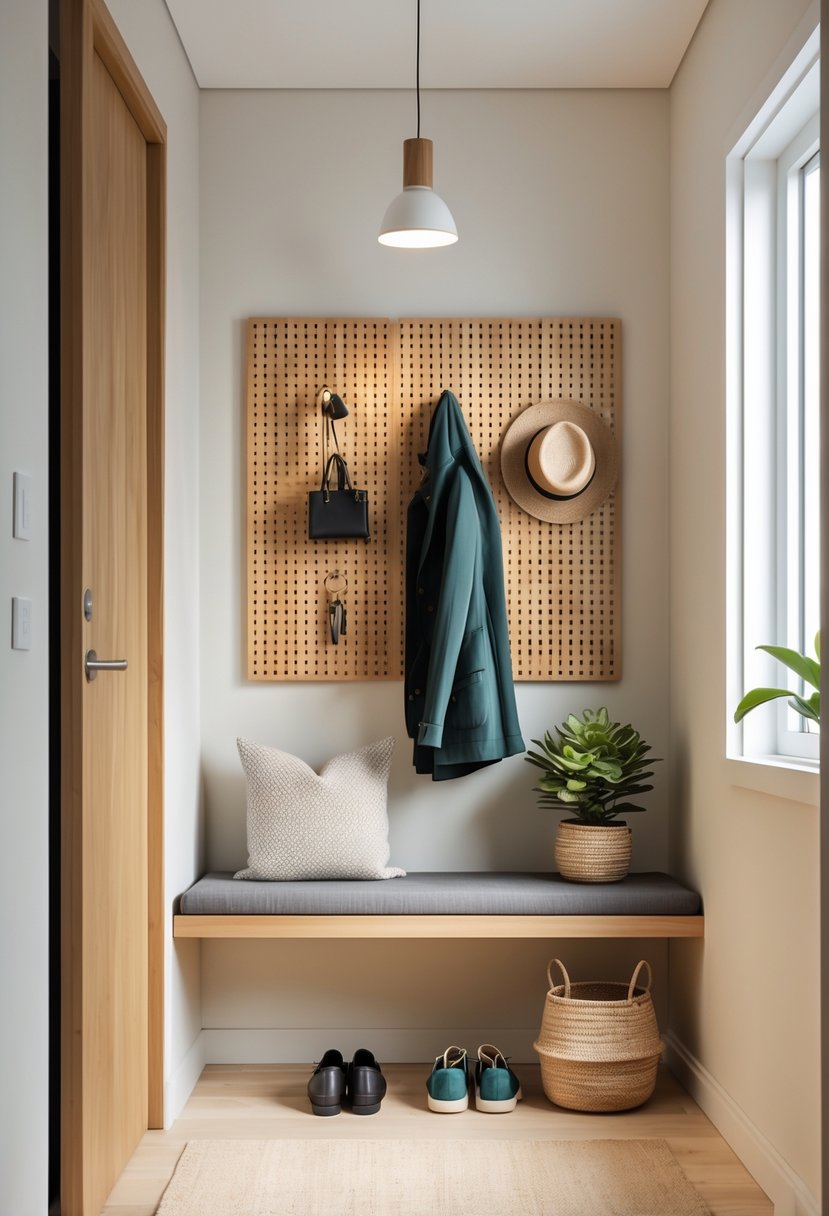
A pegboard offers adaptable storage in a small entryway. It allows hooks and shelves to be moved or added as needed.
They can hold keys, hats, bags, or small baskets for loose items. Pegboards keep things off the floor and easy to reach.
Hooks with locks or zip ties help keep items secure. This simple system can change with the seasons or daily needs.
10) Add a small rug to define the entry zone

A small rug helps mark the entry area clearly in a compact home. It creates a separate space without taking up room.
Choosing a rug with durable material is smart because it handles foot traffic well. Patterns can hide dirt and add personality.
A well-placed rug also softens hard floors and welcomes guests with warmth. It ties the entryway’s look together simply and effectively.
11) Use vertical storage like tall cabinets or cubbies
Tall cabinets make good use of vertical space, especially in small entryways. They provide room to store shoes, bags, and other items without taking up much floor space.
Cubbies are another smart choice. They fit neatly on walls and can be customized to hold hats, gloves, or keys.
Together, these options keep entryways organized and clutter-free while maximizing limited space.
12) Incorporate multifunctional furniture pieces
Multifunctional furniture helps maximize space in small entryways. Pieces like storage benches or tables with shelves offer seating and a place to keep shoes or bags.
Using these items keeps the area organized without crowding it. This approach combines style and utility, fitting well in limited spaces.
Choosing furniture with hidden storage or multiple uses makes the entryway more practical and tidy. It supports a clutter-free, efficient home entrance.
Understanding the Challenges of Small Entryways
Small entryways require careful attention to layout and function due to limited space. They call for smart choices in storage, furniture, and decor. Avoiding clutter and ensuring a smooth flow are key to making these areas both useful and welcoming.
Maximizing Limited Square Footage
Small entryways often have tight dimensions that leave little room for furniture or movement. It is important to choose slim, multi-purpose pieces like narrow benches with storage or wall-mounted shelves.
Using vertical space can add valuable storage without crowding the floor. Hooks for coats and bags, floating shelves for keys, and tall mirrors to reflect light can make the space feel larger.
Clear pathways improve flow and prevent the area from feeling cramped. Furniture placement should allow people to enter and exit without squeezing past items. A compact shoe rack or cubbies can keep floors clear.
Common Design Mistakes to Avoid
One major mistake is overfilling the entryway with bulky furniture that blocks access or crowds the space. Another is neglecting storage, which leads to clutter piling up.
Avoid deep rugs or mats that reduce usable floor area and cause tripping hazards. Poor lighting can make the space feel dark and smaller than it is, so choose bright, warm lights.
Using too many colors or patterns can overwhelm the small space. Sticking to a simple color palette helps create a calm and open feel.
Failing to plan for seasonal changes, like where to store winter coats or umbrellas, can quickly create mess. Thoughtful storage tailored to daily needs prevents this problem.
Choosing the Right Materials and Colors
Choosing materials and colors for a small entryway can greatly affect how spacious and inviting the area feels. Careful selection can enhance light, highlight features, and improve durability without crowding the space.
Light vs. Dark Color Palettes
Light colors work best for small entryways because they reflect more natural and artificial light. Shades like soft white, pale gray, or light beige create an open and airy feel. These colors help the space look larger and brighter.
Dark colors can add warmth and elegance but may make the entryway feel smaller if overused. Using deep hues like navy, charcoal, or forest green is safer on a single accent wall or in small doses through furnishings and decor.
Neutral tones offer a timeless backdrop and pair well with most styles. They provide a subtle contrast when combined with trims, doors, or floor coverings.
Space-Enhancing Material Choices
Materials that reflect light, such as glass, mirrors, and glossy finishes, help open up the entryway visually. Mirrors also serve a practical role while creating the sense of a larger space.
Light-colored wood or laminate floors increase brightness and keep the area feeling fresh. Matte or satin finishes on walls reduce glare but maintain light reflection.
Space-saving materials like slim metal or acrylic furniture maintain openness and reduce visual clutter. Durable materials like ceramic tiles or vinyl resist wear from heavy foot traffic and are easy to clean.
| Material | Benefit | Best Use |
|---|---|---|
| Mirror | Reflects light, enlarges space | Wall decor or entryway storage |
| Light wood | Bright and fresh | Flooring or small furniture |
| Glass | Open and airy feeling | Tables, stools, or light fixtures |
| Matte paint | Soft light reflection | Walls |
| Durable tiles | Easy cleaning and wear resistance | Floor |
These choices ensure both style and function in small entryways.
Frequently Asked Questions
Small entryways can be functional and stylish by using smart furniture choices and clever decor. Fitting storage into tight spots and choosing pieces that serve multiple purposes are key. Lighting and reflective surfaces also help make these areas feel larger and inviting.
How can I maximize space in a small entryway using modern design elements?
Using a slim console table with built-in storage helps keep things tidy without taking up much room. Wall-mounted hooks free up floor space for bags and coats. Floating shelves offer spots for keys, mail, and small essentials while keeping surfaces clear.
What are some effective ways to decorate a very small foyer?
Adding a decorative mirror can visually expand the entryway by reflecting light and creating depth. A neutral color scheme keeps the space bright and open. Simple artwork or a small plant adds personality without cluttering the area.
How can I create an elegant entrance in a compact living space?
Placing a cushioned bench with hidden storage adds comfort and utility. Choose sleek, minimal designs in materials like metal or wood for a modern look. Incorporating a stylish rug beneath anchors the space and adds warmth.
What are some space-saving furniture ideas for small apartment entryways?
Slimline console tables, wall hooks, and floating shelves are excellent choices. A bench with built-in storage serves dual purposes. Furniture that is raised off the floor or mounted keeps passageways clear and easy to navigate.
How can I enhance a small entryway with wall decor and accessories?
Mirrors are the best tool for opening up the space visually. Hooks and shelves keep items off the floor and organized. Small framed prints or a clock add character without crowding the walls.
Where can I find inspiration for decorating a small entryway on a budget?
Online platforms like home design blogs and social media pages offer many budget-friendly ideas. Thrift stores and flea markets can provide affordable decorative pieces. DIY projects, such as painting or customizing hooks, give entryways a personal touch.
